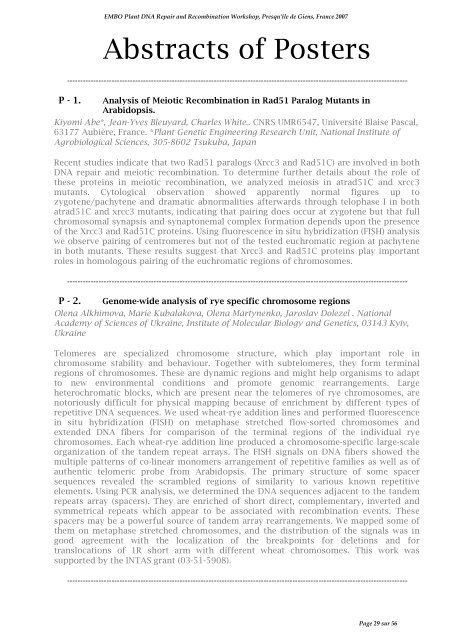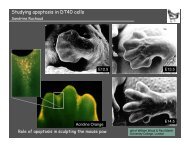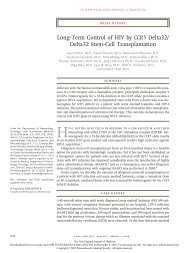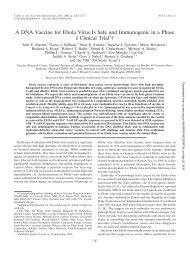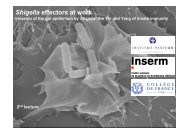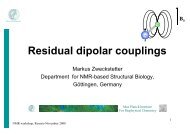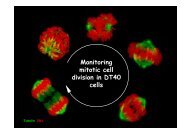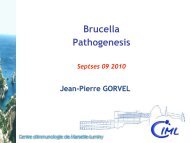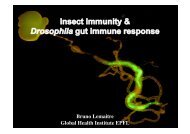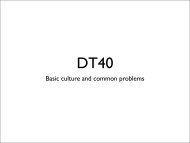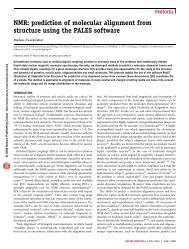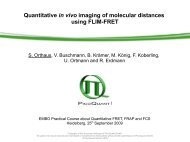pdf file - Events - EMBO
pdf file - Events - EMBO
pdf file - Events - EMBO
You also want an ePaper? Increase the reach of your titles
YUMPU automatically turns print PDFs into web optimized ePapers that Google loves.
<strong>EMBO</strong> Plant DNA Repair and Recombination Workshop, Presqu'île de Giens, France 2007<br />
Abstracts of Posters<br />
----------------------------------------------------------------------------------------------------------------------------------<br />
P - 1. Analysis of Meiotic Recombination in Rad51 Paralog Mutants in<br />
Arabidopsis.<br />
Kiyomi Abe*, Jean-Yves Bleuyard, Charles White.. CNRS UMR6547, Université Blaise Pascal,<br />
63177 Aubière, France. *Plant Genetic Engineering Research Unit, National Institute of<br />
Agrobiological Sciences, 305-8602 Tsukuba, Japan<br />
Recent studies indicate that two Rad51 paralogs (Xrcc3 and Rad51C) are involved in both<br />
DNA repair and meiotic recombination. To determine further details about the role of<br />
these proteins in meiotic recombination, we analyzed meiosis in atrad51C and xrcc3<br />
mutants. Cytological observation showed apparently normal figures up to<br />
zygotene/pachytene and dramatic abnormalities afterwards through telophase I in both<br />
atrad51C and xrcc3 mutants, indicating that pairing does occur at zygotene but that full<br />
chromosomal synapsis and synaptonemal complex formation depends upon the presence<br />
of the Xrcc3 and Rad51C proteins. Using fluorescence in situ hybridization (FISH) analysis<br />
we observe pairing of centromeres but not of the tested euchromatic region at pachytene<br />
in both mutants. These results suggest that Xrcc3 and Rad51C proteins play important<br />
roles in homologous pairing of the euchromatic regions of chromosomes.<br />
----------------------------------------------------------------------------------------------------------------------------------<br />
P - 2. Genome-wide analysis of rye specific chromosome regions<br />
Olena Alkhimova, Marie Kubalakova, Olena Martynenko, Jaroslav Dolezel . National<br />
Academy of Sciences of Ukraine, Institute of Molecular Biology and Genetics, 03143 Kyiv,<br />
Ukraine<br />
Telomeres are specialized chromosome structure, which play important role in<br />
chromosome stability and behaviour. Together with subtelomeres, they form terminal<br />
regions of chromosomes. These are dynamic regions and might help organisms to adapt<br />
to new environmental conditions and promote genomic rearrangements. Large<br />
heterochromatic blocks, which are present near the telomeres of rye chromosomes, are<br />
notoriously difficult for physical mapping because of enrichment by different types of<br />
repetitive DNA sequences. We used wheat-rye addition lines and performed fluorescence<br />
in situ hybridization (FISH) on metaphase stretched flow-sorted chromosomes and<br />
extended DNA fibers for comparison of the terminal regions of the individual rye<br />
chromosomes. Each wheat-rye addition line produced a chromosome-specific large-scale<br />
organization of the tandem repeat arrays. The FISH signals on DNA fibers showed the<br />
multiple patterns of co-linear monomers arrangement of repetitive families as well as of<br />
authentic telomeric probe from Arabidopsis. The primary structure of some spacer<br />
sequences revealed the scrambled regions of similarity to various known repetitive<br />
elements. Using PCR analysis, we determined the DNA sequences adjacent to the tandem<br />
repeats array (spacers). They are enriched of short direct, complementary, inverted and<br />
symmetrical repeats which appear to be associated with recombination events. These<br />
spacers may be a powerful source of tandem array rearrangements. We mapped some of<br />
them on metaphase stretched chromosomes, and the distribution of the signals was in<br />
good agreement with the localization of the breakpoints for deletions and for<br />
translocations of 1R short arm with different wheat chromosomes. This work was<br />
supported by the INTAS grant (03-51-5908).<br />
----------------------------------------------------------------------------------------------------------------------------------<br />
Page 29 sur 56


